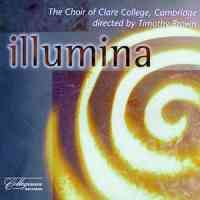
Illumina
The Choir of Clare College, Cambridge, Timothy Brown
Retrospectively the disc's final item, Ligeti's Luxaeterna, dominates the recital. Not only does it make an indelible impression, but it also casts its light over the entire programme and style... — More…
CD
$17.25Contents
Gregorian Chant: Lumen
- Choir of Clare College Cambridge
- Timothy Brown
Harris, W: Bring us, O Lord God
- Choir of Clare College Cambridge
- Timothy Brown
Rautavaara: Ehtoohymni (Evening hymn)
- Choir of Clare College Cambridge
- Timothy Brown
Rachmaninoff: Nunc Dimittis
- Choir of Clare College Cambridge
- Timothy Brown
Byrd: O Lux beata Trinitas
- Choir of Clare College Cambridge
- Timothy Brown
Hildegard: O coruscans lux stellarum
- Choir of Clare College Cambridge
- Timothy Brown
Tallis: O nata lux de lumine
- Choir of Clare College Cambridge
- Timothy Brown
Tallis: Te lucis ante terminum
- Choir of Clare College Cambridge
- Timothy Brown
Rutter: Hymn to the Creator of Light
- Choir of Clare College Cambridge
- Timothy Brown
Wood, C: Hail, gladdening Light
- Choir of Clare College Cambridge
- Timothy Brown


